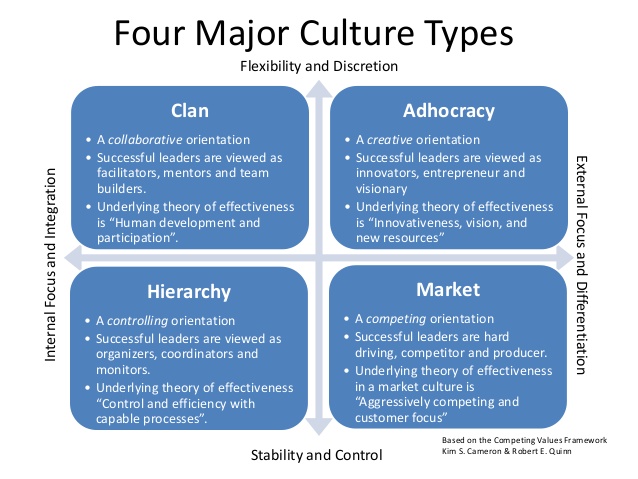Opinno was involved in a change management project with a Spanish financing institution. The primary purpose of the project was to increase organizational effectiveness.
We created a workshop where, together with the company’s executive team, we mapped the organisational values. Our innovation team used the Competing Values Framework recognised as one of the most effective ways of understanding corporate culture. Whenever an organisation wants to be more competitive and change an aspect of the way it conducts business, it has to address the corporate culture, the internal values that drive people, programs, and policies.
Kim Cameron, a leading researcher in organisational leadership, defines the Competing Values Framework as “a map, an organising mechanism, a sense-making device, a source of new ideas, and a theory of management and organisational performance.”
The Competing Values Framework was created in 1983 by Robert Quinn and John Rohrbaugh. It looks at individual leadership behaviour and how that behaviour produces competences but more importantly how those competencies produce very specific types of value. Throughout their research, Quinn and Rohrbaugh found out that effective companies are dealing with two balancing acts: focus (some companies were effective when they focused on the internal processes, while others were effective when they maintained a competitive external positioning) and stability (some organizations showed efficiency when they demonstrated flexibility and adaptability while others succeeded because they were run by stability and control).

The competing values framework describes four types of organisations. We will explain each of them in detail.
1. The ADHOCRACY is an externally-focused, highly innovative, and flexible company. This type of organisation likes to take risks. Creative ideas and diversity drive the company to success. Leadership is visionary, innovative and synergy-creating. In times of uncertainty, this type of organisation has the internal resources to reinvent itself. It quickly makes sense of ambiguity and instability as adaptability and flexibility are its main forces. The capacity to innovate and become memorable is what defines success in this type of company.
2.The MARKET-oriented company became popular in the ‘60’ when organisations were trying to adapt to the new challenges of the market. A way to build an effective organisation was to adapt to market mechanisms. This organisation is externally focused, continually looking to compete, control, and gain competitive advantage. This type of company operates through economic transactions, seeking to acquire new clients, contracts, and sales. Achieving goals and winning are what hold this company together — and making money.
3.The HIERARCHY organisation is internally focused, run by control, order and continuous improvement. It is a procedural and formalised place to work. Leadership is quality-focused and has a long-term vision for the organisation as a predictable, stable structure based on clear rules and formal policies.
4. The FAMILY or CLAN type organisation is held together by shared values like stability, cohesion, participation, and succeeding as a team. This is a people-focused organisation where employees share a lot about themselves, leaders are often regarded as mentors, and there is a high emphasis on personal development and fulfilment through work. Management is incredibly good at building a sustainable company. Risk taking is uncommon in this type of organisation. In the top left corner, we find companies that are focused on the inside. The downside of this type of organisation is the lack of flexibility and adaptability.
How is the Competing Values Framework creating value for your company?
There is no right or wrong answer when trying to figure out what type of organisation you are. You have to choose what kind of organisation you want to be and disseminate those values throughout the organisation. Companies must be competent in all four quadrants of the competing values framework to be profitable because some situations require more than one approach to problem-solving.
The competing values framework is about creating positive tension by putting the right combination of people with different competencies to produce the required types of innovations.



